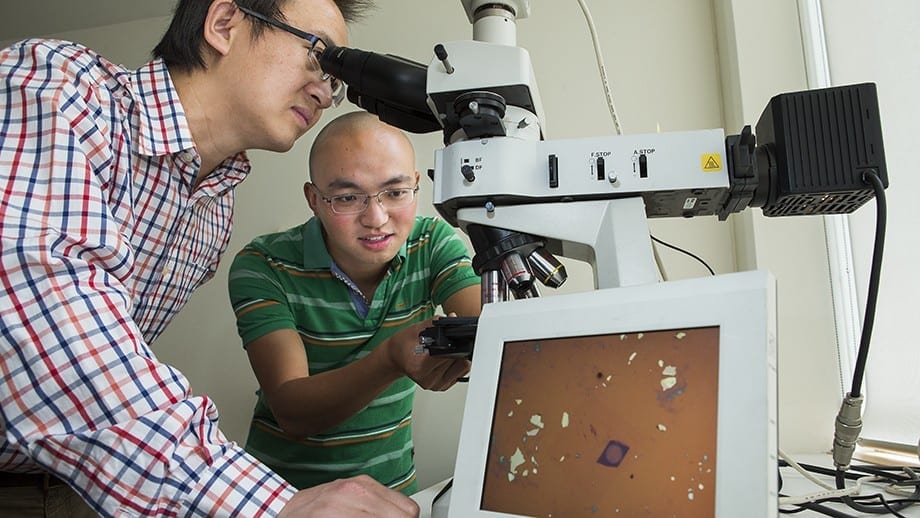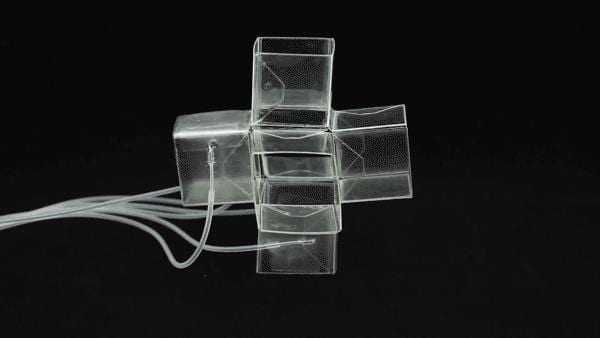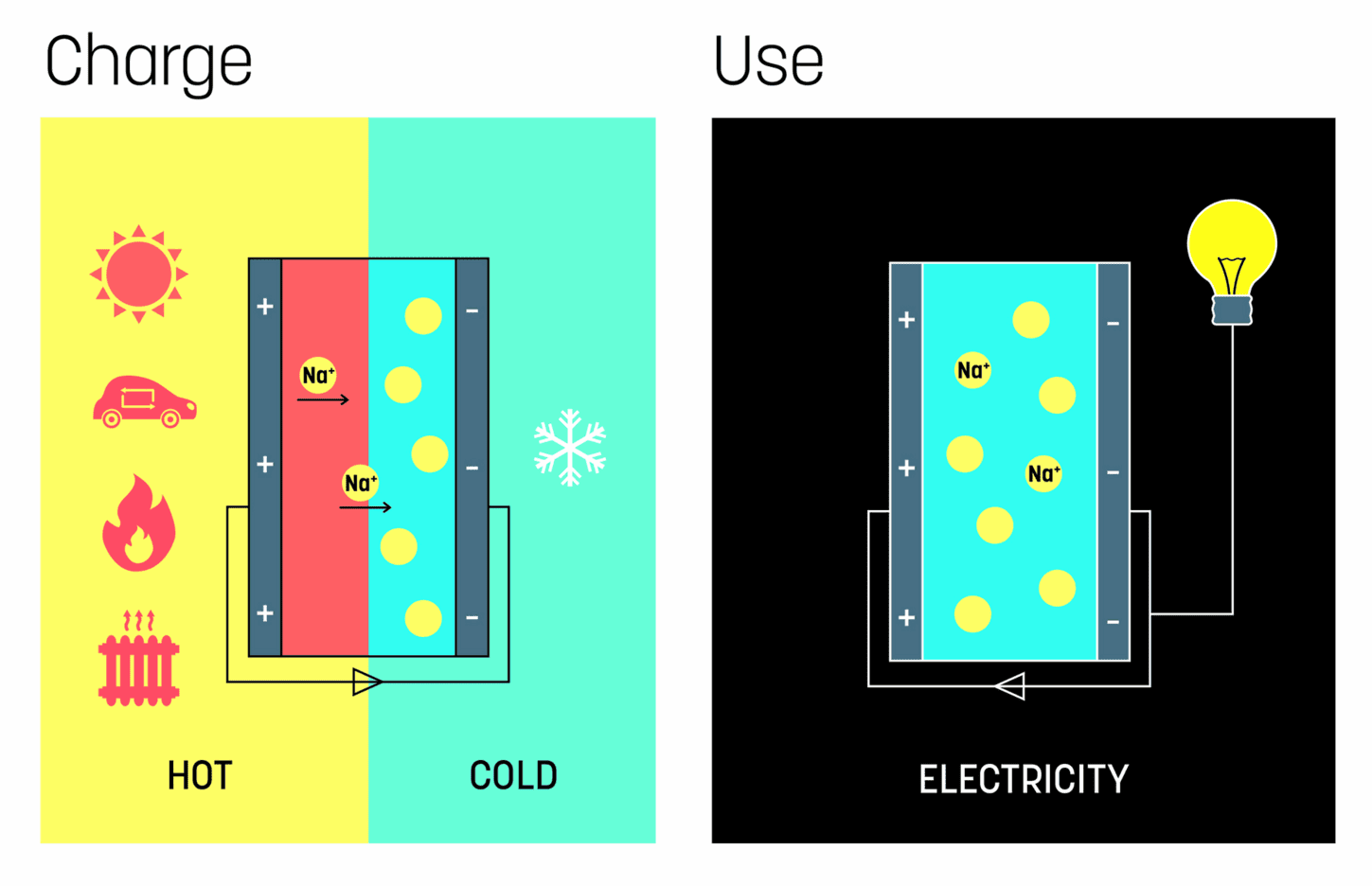
Scientists have created the world’s thinnest lens, one two-thousandth the thickness of a human hair, opening the door to flexible computer displays and a revolution in miniature cameras.
Lead researcher Dr Yuerui (Larry) Lu from ANU Research School of Engineering said the discovery hinged on the remarkable potential of the molybdenum disulphide crystal.
“This type of material is the perfect candidate for future flexible displays,” said Dr Lu, leader of Nano-Electro-Mechanical System (NEMS) Laboratory in the ANU Research School of Engineering.
“We will also be able to use arrays of micro lenses to mimic the compound eyes of insects.”
The 6.3-nanometre lens outshines previous ultra-thin flat lenses, made from 50-nanometre thick gold nano-bar arrays, known as a metamaterial.
“Molybdenum disulphide is an amazing crystal,” said Dr Lu
“It survives at high temperatures, is a lubricant, a good semiconductor and can emit photons too.
“The capability of manipulating the flow of light in atomic scale opens an exciting avenue towards unprecedented miniaturisation of optical components and the integration of advanced optical functionalities.”
Molybdenum disulphide is in a class of materials known as chalcogenide glasses that have flexible electronic characteristics that have made them popular for high-technology components.
Dr Lu’s team created their lens from a crystal 6.3-nanometres thick – 9 atomic layers – which they had peeled off a larger piece of molybdenum disulphide with sticky tape.
They then created a 10-micron radius lens, using a focussed ion beam to shave off the layers atom by atom, until they had the dome shape of the lens.
The team discovered that single layers of molybdenum disulphide, 0.7 nanometres thick, had remarkable optical properties, appearing to a light beam to be 50 times thicker, at 38 nanometres. This property, known as optical path length, determines the phase of the light and governs interference and diffraction of light as it propagates.
“At the beginning we couldn’t imagine why molybdenum disulphide had such surprising properties,” said Dr Lu.
Collaborator Assistant Professor Zongfu Yu at the University of Wisconsin, Madison, developed a simulation and showed that light was bouncing back and forth many times inside the high refractive index crystal layers before passing through.
Molybdenum disulphide crystal’s refractive index, the property that quantifies the strength of a material’s effect on light, has a high value of 5.5. For comparison, diamond, whose high refractive index causes its sparkle, is only 2.4, and water’s refractive index is 1.3.
Learn more: World’s thinnest lens to revolutionise cameras
The Latest on: Molybdenum disulphide crystal
[google_news title=”” keyword=”molybdenum disulphide crystal” num_posts=”10″ blurb_length=”0″ show_thumb=”left”]
via Google News
The Latest on: Molybdenum disulphide crystal
- Light stands still in a deformed crystalon April 23, 2024 at 5:00 pm
AMOLF researchers, in collaboration with Delft University of Technology, have succeeded in bringing light waves to a halt by deforming the two-dimensional photonic crystal that contains them.
- Crystal Raypoleon April 17, 2024 at 6:59 pm
Crystal Raypole’s work appears on Healthline, and she’s previously worked as a writer and editor for GoodTherapy. Her interests include Japanese language and translation, cooking, natural ...
- Billy Crystal's 2 Kids: All About Jennifer and Lindsayon April 14, 2024 at 7:00 am
Presley Ann/Getty Actor Billy Crystal might be known forever to many as Harry from the 1989 film When Harry Met Sally, but to Jennifer Crystal Foley and Lindsay Crystal, he’s always been Dad.
- What Exactly Are Crystal Crabs And What Do They Taste Like?on February 19, 2024 at 10:32 am
Crystal crabs (Chaceon albus) are a breed of crab found in the waters off Australia's western coast. These striking animals are known for both their appearance and taste. As a result, they are ...
- Wireless Detectorson May 12, 2023 at 11:25 pm
in the Molybdenite Detector between a crystal of molybdenum disulphide and a metallic surface; in the Galena detector between a-crystal of lead sulphide and a very fine wire; in the Carborundum ...
- Crystal Dynamicson January 22, 2023 at 12:36 pm
A new Tomb Raider game may be in the works, according to recent rumors. Reportedly, the upcoming game takes Lara… Crystal Dynamics‘ new website for the Tomb Raider series has revealed artwork ...
- Crystal Skullson May 20, 2022 at 11:39 pm
Crystal skulls are not uncommon or terribly mysterious. Thousands are produced every year in Brazil, China, and Germany. But there are a handful of these rather macabre objects that have fueled ...
- Tungsten and Molybdenum for Growing Sapphire Crystalson March 7, 2019 at 2:59 am
Let us help you with your inquiries, brochures and pricing requirements Request A Quote Download PDF Copy Download Brochure H.C. Starck Soutions' range supports the ...
- Getting Serious About Crystal Radioson April 7, 2016 at 12:20 am
A crystal radio is basically a high Q resonator tied to an antenna and an envelope detector. These days the envelope detector is a point contact diode such as a 1N34 Germanium diode. The resonant ...
- Molybdenum, Moon November 26, 2014 at 3:30 am
The electronic configuration of Molybdenum is: (Kr)(4d) 5 (5s) 1, and it has an atomic radius of 0.139 nm. At room temperature the metal has the body centered cubic crystal structure. The lattice ...
via Bing News










